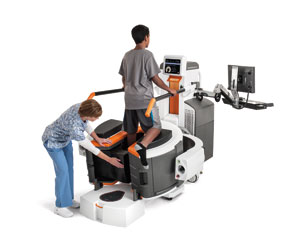Chief Technology Officer Discusses Clinical Studies of Cone Beam CT Technology
UBMD Orthopaedics & Sports Medicine Investigating Carestream’s CBCT Technology to Acquire Weight-Bearing 3D Images of Extremity Injuries
ROCHESTER, N.Y., Nov. 3 — Specialists from UBMD Orthopaedics & Sports Medicine are investigating Carestream’s cone beam CT (CBCT) technology to capture images of patients with orthopaedic conditions as part of ongoing clinical studies. The CBCT system will be on display at Carestream’s booth at the Radiological Society of North America (RSNA) conference. The CBCT system used in these studies is INVESTIGATIONAL and NOT AVAILABLE FOR COMMERCIAL SALE.
“Orthopaedics is a major area of focus for our company because of the prevalence of musculoskeletal conditions among people of all ages,” said James Burns, Carestream’s Chief Technology Officer for the Digital Medical Solutions business. “We are actively involved in evaluating CBCT and other types of imaging technologies that may be able to provide diagnostic information that is not readily available using existing imaging systems.”
 UBMD Orthopaedics & Sports Medicine and Carestream are conducting an institutional IRB-approved clinical study designed to help orthopaedic surgeons more accurately and objectively diagnose the degree of instability of the patella (knee cap). Two of the challenges of this condition are identifying the cause of patella dislocation and then calculating the amount of correction that would be necessary when tibial tubercle transfer surgery is planned.
UBMD Orthopaedics & Sports Medicine and Carestream are conducting an institutional IRB-approved clinical study designed to help orthopaedic surgeons more accurately and objectively diagnose the degree of instability of the patella (knee cap). Two of the challenges of this condition are identifying the cause of patella dislocation and then calculating the amount of correction that would be necessary when tibial tubercle transfer surgery is planned.
“We compare images obtained on a conventional CT scanner to those obtained on the prototype CBCT scanner while the patient is standing, the quadriceps is active and the knee is flexed to 30 degrees,” said Dr. John Marzo, a physician with UBMD Orthopaedics & Sports Medicine, Associate Professor of Clinical Orthopaedics, School of Medicine & Biomedical Sciences, University at Buffalo and former Medical Director, Buffalo Bills.
“The orthopaedic specialists involved in the clinical study are extremely satisfied with image quality from the CBCT scanner and have provided positive feedback on the benefits provided by the use of this technology for weight-bearing exams,” he adds.
Another research project is attempting to validate computational measures of joint surface area of contact and joint surface pressure using weight-bearing images from the cone beam CT scanner.
“This CBCT scanner has the potential to become a non-invasive tool to evaluate a host of orthopaedic conditions that affect the biomechanical behavior of the joints, such as arthritis, meniscus loss, instability and malalignment syndromes,” reports Burns.
These clinical studies and other research projects will help guide Carestream’s development of new CBCT systems with the goal of providing orthopaedic solutions for hospitals, clinics and sports medicine providers that use less radiation than traditional CT; are compact and affordable; and could be used in a wide range of facilities.
To view information about Carestream systems being demonstrated at RSNA or to make a booth appointment, please visit www.carestream.com/rsna.